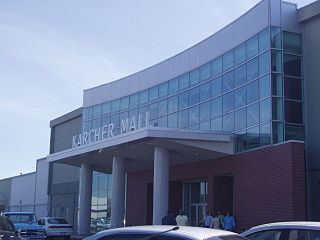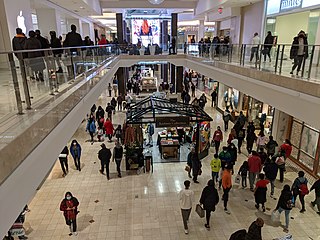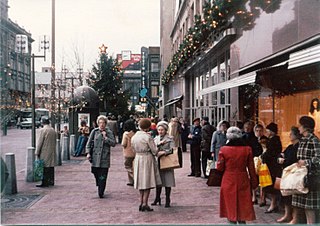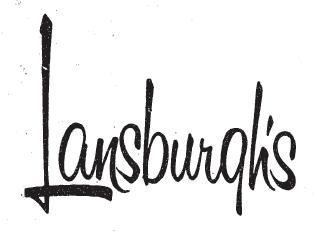
Macy's is an American department store chain founded in 1858 by Rowland Hussey Macy. It has been a sister brand to the Bloomingdale's department store chain since being acquired by holding company Federated Department Stores in 1994, which renamed itself Macy's, Inc. in 2007. It is the largest department store company by retail sales in the United States as of 2023.

King of Prussia, also referred to as King of Prussia Mall, and referred to locals as KOP, is a shopping mall located in the community of King of Prussia in Upper Merion Township, Pennsylvania. It is the largest shopping mall in Pennsylvania and the third-largest shopping mall in the United States in terms of gross leasable area. It is an upscale mall with 450 retailers.

Tysons Corner Center is a shopping mall in the unincorporated area of Tysons in Fairfax County, Virginia, United States. It opened to the public in 1968, becoming one of the first fully enclosed, climate-controlled shopping malls in the Washington metropolitan area. The mall's anchor department stores are Macy's, Nordstrom, and Bloomingdale's. The mall also features prominent specialty retailers including Everlane, Fabletics, Untuckit, Oak + Fort, Intimissimi, Aesop, and Warby Parker.

Wanamaker's, originally known as John Wanamaker Department Store, was one of the first department stores in the United States. Founded by John Wanamaker in Philadelphia in 1861, it was influential in the development of the retail industry including as the first store to use price tags.
Hecht's, also known as Hecht Brothers, Hecht Bros. and The Hecht Company, was a large chain of department stores that operated mainly in the mid-Atlantic and southern region of the United States. The firm originated in Baltimore, Maryland.
Strawbridge's, formerly Strawbridge & Clothier, was a department store in the northeastern United States, with stores in Pennsylvania, New Jersey, and Delaware. The Center City Philadelphia flagship store was, in its day, a gracious urban emporium. The retailer started adding branch stores starting in the 1930s and, by their zenith in the 1980s, enjoyed annual sales of over a billion dollars By the 1990s, Strawbridge's became part of the May Department Stores conglomerate until May's acquisition by Federated Department Stores on August 30, 2005.

Westmoreland Mall is a two-level, enclosed super-regional shopping and casino complex in the municipality of Hempfield Township, Pennsylvania, southeast of Pittsburgh, and owned and operated by CBL Properties. It was completed in 1977 and was extensively renovated and expanded in 1993–1994. The mall features retailers JCPenney, Macy's, and Macy's Home, in addition to Live! Casino Pittsburgh and a future Dick's House of Sport store in the space formerly occupied by Sears.

District 208, formerly Karcher Mall, is a shopping center located in Nampa, Idaho, United States. It originally opened as an enclosed shopping mall in August 1965 with Buttrey Food & Drug, Tempo, and Sprouse-Reitz as anchor stores. It was the largest shopping mall in the Treasure Valley until the opening of Boise Towne Square in Boise in October 1988. The shopping center is anchored by Big 5 Sporting Goods, Jo-Ann Fabrics and Crafts, Mor Furniture, and Ross.
The Mall at Prince George's, formerly known as Prince George's Plaza, is an enclosed regional shopping mall located in Hyattsville, Maryland, at the intersection of Belcrest Road and East-West Highway. It is served by a Washington Metro station, Hyattsville Crossing. This station is on the Green Line. Located across Belcrest Road from the Mall is the University Town Center mixed-use development.
Filene's Basement, also called The Basement, was a Massachusetts-based chain of department stores which was owned by Retail Ventures, Inc. until April 2009 when it was sold to Syms.

Garfinckel's was a prominent department store chain based in Washington, D.C. that catered to a clientele of wealthy consumers. Its flagship store at 14th and F in the city's F Street shopping district is listed on the National Register. It filed for Chapter 11 bankruptcy in June 1990 and ceased operations that year.

Fair Oaks Mall is a shopping mall in the Fair Oaks census-designated place (CDP) of unincorporated Fairfax County, Virginia, just northwest of the independent city of Fairfax. It is located at the intersection of Interstate 66 and U.S. Route 50. The mall has a gross leasable area (GLA) of 1,557,000 sq ft (144,700 m2). The mall features the traditional retailers Macy's, Macy's Furniture Gallery, JCPenney, Dick's Sporting Goods and Dave & Buster's. The mall also features prominent specialty retailers such as Apple, Ardene, Pottery Barn, Windsor, Sephora, and Williams Sonoma.

Westfield Montgomery is a shopping mall in Bethesda, Maryland. Major tenants include Macy's, Macy's Home, and Nordstrom, as well as specialty brands such as Fabletics, Madewell, Vineyard Vines, and Untuckit.

The Globe Store was a regional department store in Scranton, Pennsylvania, founded in 1883 by John Simpson and John Clelland. It closed in 1994.

Westfield Wheaton, formerly known as Wheaton Plaza, is a 1.7 million square-foot, two-level indoor shopping mall in Wheaton, Maryland, north of Washington, D.C. It is owned by Unibail-Rodamco-Westfield and Its anchor stores include Macy’s, Target, JCPenney, Dick's Sporting Goods, and Costco.

Lansburgh's was a chain of department stores located in the Washington, D.C. area. The clientele were middle-income consumers.

The Shops at National Place was a three-level, indoor shopping mall located in downtown Washington, D.C. in the 16-story National Place Building. It is located on the block bounded by Pennsylvania Avenue, F Street, between 13th and 14th Streets NW, the former site of the Munsey Trust Building. It was located near the Metro Center station of the Washington Metro system.

Parts of F Street and 7th Street, N.W. and nearby blocks have historically been the heart of the Washington, D.C. Downtown shopping district. In the first half of the 20th century there were numerous upscale large department stores along and near F Street, while 7th Street housed more economical emporia and large retail furniture stores. The F street corridor stretches west from Downtown's Penn Quarter and Gallery Place towards 15th Street, while the 7th Street corridor includes the neighborhoods of Penn Quarter, Chinatown and Mount Vernon Square, and extends up to the border of Shaw.

Retail in Southern California dates back to its first dry goods store that Jonathan Temple opened in 1827 on Calle Principal, when Los Angeles was still a Mexican village. After the American conquest, as the pueblo grew into a small town surpassing 4,000 population in 1860, dry goods stores continued to open, including the forerunners of what would be local chains. Larger retailers moved progressively further south to the 1880s-1890s Central Business District, which was later razed to become the Civic Center. Starting in the mid-1890s, major stores moved ever southward, first onto Broadway around 3rd, then starting in 1905 to Broadway between 4th and 9th, then starting in 1915 westward onto West Seventh Street up to Figueroa. For half a century Broadway and Seventh streets together formed one of America's largest and busiest downtown shopping districts.

Palais Royal was a large department store in Washington, D.C. at 11th and G streets NW in the F Street shopping district. It also grew into a small chain before being purchased and merged into the Woodward & Lothrop chain.



















